| Wildlife Conservation in Botswana |
|
[Last updated: 01-Aug-2022]
| Start | | | Week 1 | | | Week 2 | | | Week 3 | | | Week 4 | | | Week 5 | | | Week 6 |
We finally arrived at the Motswiri Camp (GPS: S22°18'4.30" E28°52'15.80") at about 15:20, and by the looks of it, miles from anywhere! We were a lot more shaken from the journey; but it was a superb introduction to African bush life! See the camp from above, in Google Maps or in Google Earth.
One of the first sights to greet us was the large amount of fence wire (Photo BW-005) that had been collected, presumably by previous volunteers!
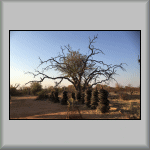 Photo BW-005 |
Caroline and I were introduced to the only PA volunteer at the camp, Esteban (from the French-speaking part of Switzerland), who had been at the camp for two weeks. Then we were introduced to the other members of staff, and given an induction session of the site. There are usually two working sessions per day; the first normally starts at 07:00 and the second at 14:30. The volunteers are driven to their place of work, either by Dicks or by Jo (short for Johannes); who are the two resident guides. The projects are decided by the camp manager (usually on a daily basis) and written on a whiteboard, located by the kitchen.
As we were the newcomers, Jo took Caroline and I for a 'safari tour' of the local area at 17:00. In no time at all, we saw:
In and around the camp site, numerous birds could be seen and heard. There was (is?) an information sheet on the wall in the 'lounge' area that lists the ten bird species that can be spotted around the bird table. Click this link to show/hide the list.
After dinner (which was minced meat and rice (I thought I'd had enough
rice when I was in Thailand)), the three of us sat around the open camp
fire (that wouldn't initially light). While we were there, two
Bushpigs came to
eat some of the food waste that had been put out. I retired to my tent
at 20:30, absolutely exhausted! Plus, tomorrow was an early start (07:00)!
Needless to say, I quickly went to sleep; I went out like a light!
Tuesday, 06-Sep-2016
Today's two projects: Wire Removal and a Mammal Census.
My alarm woke me up at 06:20 - after having had a good night's sleep. I took a short walk to the kitchen, for breakfast. I wasn't the first; Jo (our driver) had already arrived.
In days gone by, the land owners had wire fences along 'cut lines' around their properties. These fences would restrict (or even prevent!) animal movements. Most of the wire fences have been removed (or are being removed if they still exist) to allow the wild animals to travel without any restrictions. However, in places, the actual wire has been left in situ, being a potential hazard to the wildlife. Thus, the activity involves the volunteers walking along selected cut lines (or wherever it was thought there was wire), searching for discarded lengths of wire, winding the lengths into manageable loops, and transporting them back to the camp (see Photo BW-005), to await future disposal.
This activity is potentially dangerous, in that the ends of the wire can whip and spring about, causing injury! That is actually what happened to me later during my stay. I (fortunately) only suffered scratched spectacle lenses. If I hadn't been wearing them, I might have lost the sight from one or both eyes!
In the time we were at the designated cut line, we estimated that we had retrieved approximately 300 metres of wire, but there was more still to collect. When it became too hot to continue (at about 10:30) Jo drove us back to the camp (where Jane had prepared some delicious pancakes).
On our way back from the cut line, we passed South African Giraffes, Kudus and Zebras.
Lunch was served at 11:30, after which, everyone had free time, until the next activity at 14:30.
The afternoon's exercise was a Mammal Census, whereby volunteers are driven to a particular location. Observations had to be made of the animals seen, listing the time, the property the animals were on (WT = Wild at Tuli, S = Sukses (pronounced like 'success') and M = Mopane (pronounced mo-pa-né), the GPS location, the number, the gender and lastly, the estimated age (adult, sub-adult or juvenile) of the animals. During today's exercise, we saw baboons, impalas, zebras and elands.
However, at the waterhole a few hundred metres from the camp, we came across a rather excited elephant (Photo BW-006), that appeared to start 'dancing'! What happened next can be seen in the first few minutes of Video BW-001.
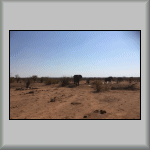 Photo BW-006 |
An Angry Elephant, and more Video BW-001 [6 minutes, 16 seconds] |
It also contains a few (distant) views of some of animals that we saw that afternoon: three Zebras, two more Elephants, a close-up of a Leopard Tortoise, Impalas (by the koppie/kopje) and Elands (in the bush). In the final seconds, two (silver-grey coloured) Baobab trees can be seen. The one on the left is nicknamed "Big Mama" (Photo BW-007) because of its size, and the smaller one on the right is nicknamed "Frankenstein" (probably because of the way its branches have grown, resembling his hair?)! We got a closer view of "Big Mama" on Friday afternoon.
Today's census included checking three animal camera traps that had previously been set up (near to GPS: S22°21'56.00" E28°55'8.00"), where Photo BW-008 was taken.
Unfortunately, when we got to where the cameras had been positioned, one of the cameras was missing from where it had been positioned! It was eventually found on the ground, in pieces, not far away. Fortunately, the SD card inside the camera was intact and the culprit was clearly identifiable; a lovely elephant!
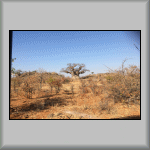 Photo BW-007 |
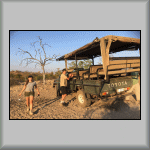 Photo BW-008 |
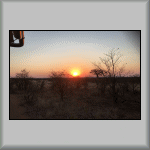 Photo BW-009 |
Dicks continued driving the three of us around (to complete the mammal census); where we saw Baboons, Common Elands, Impalas and Zebras.
Back at camp, I admired my first sunset in Botswana; see Photo BW-009. Jane had
prepared spaghetti bolognaise for dinner; which was yummy! Then the
three of us went and
sat around the camp fire and admired the stars!
There was absolutely no light
polution to spoil the view of the Milky Way,
the planets, etc. What a way to end the day!
Wednesday, 07-Sep-2016
Today's two projects: The Dam Project and a Crocodile Census.
It was a warm night; the minumum temperature was 20°C. On my way to breakfast, the sunrise cast a 'calming morning light' over the camp, which I captured in the following four photos.
 Photo BW-010 |
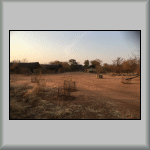 Photo BW-011 |
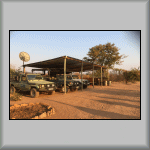 Photo BW-012 |
 Photo BW-013 |
At 07:00, we set off for the dam (GPS: S22 17' 37.10" E28 52' 30.60"), which was situated about 1.5 Km from the camp. It's construction had been started by previous volunteers.
The idea behind the building of the dam was that during the rainy season, the river flowing towards the dam would create a small reservoir (on its western side), which would provide a valable source of water for the animals.
Water in this part of the world is very precious, especially during the dry season (now). Our job was to add the final few rocks and stones (of which there were plenty lying around) to the top of the structure; which was about 2 metres high. The rocks and stones were bonded together with a mix of cement (purchased) and sand (from the river bed); see Photo BW-014.
We finished at about 09:30 and by 10:00 (back at the camp), the temperature had risen to 29°C! The decision as to whether the dam was at the required height was to be made later, by Judi and/or Helena. However, my immediate need was to have a shower, because some of the cement mix had ended up in my hair! It was my own fault for being too close to the action!
For the afternoon crocodile census, Dicks drove the three of us to the Limpopo River (Photo BW-015 and Photo BW-016) to conduct a Crocodile Census. As it was a hot day, we only saw one crocodile out of the water - until it decided to go and submerge itself in the pool! [Due to it being the dry season, the river was not flowing. Instead, there were numerous pools along its course.] A number of other crocodiles were in the water, with only their eyes and snout visible; the rest of their bodies were below the surface. Details of the crocodiles we saw, and where we saw them, were noted on a census sheet.
The highlight of the afternoon, however, was seeing a hippopotamus in the water; well, just it's ears, eyes, and the top part of it's head!
By the time we arrived back at camp, it was completely dark. Jane had prepared a fantastic soup and freshly baked home-made bread. Excellent, after a hard day's work! Caroline, Esteban and myself ended the evening playing cards - Cambio (Cabo); highly amusing!
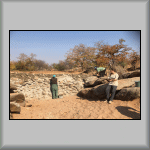 Photo BW-014 |
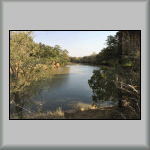 Photo BW-015 |
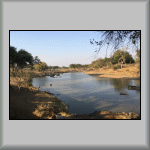 Photo BW-016 |
Today's two projects: Anti-Poaching Patrol and the Dam Project.
En route to the anti-poaching site, we observed one very tall termite mound (Photo BW-017), free-roaming cattle, Wildebeest (or Gnu) and Zebras.
The purpose of the anti-poaching patrols (Photo BW-018) are to walk through specific parts of the bush, searching for, and retrieving, wire snares that have been set by animal poachers. During this morning's activity, one snare was found, along with a length (approximately 30 metres) of wire.
For the afternoon activity, we had to wait to hear if additional work was required at the dam. Fortunately, it wasn't; it's height was perfect. Therefore, the replacement activity was Road Repair. This required volunteers (under the guidance of Dicks and/or Jo) to remove tree branches and other obstacles (for example, rocks and tree roots) from the roads (tracks!) - using spades, axes, picaxes and machetes - in order to improve the ride comfort.
A short-cut track to the tarmac road (to Bobonong, etc.) had already been planned and started, bypassing the Tuli Reserves Road and Lekkerpoet Junction, and reducing the journey time by up to 30 minutes. The only obstacle in the way were several hundred metres of bush and the crossing of a river. This afternoon's activity was to clear the track (Photo BW-019 and Photo BW-020).
After a productive afternoon, we returned to the camp; (Photo BW-021). The tent that was my home, and the shower/toilet building (on the left and right respectively) can be seen in Photo BW-022. The two white upturned enamelled bowls, leaning against the wall, are what the volunteers used to wash their clothes!
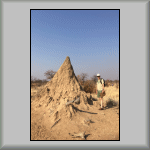 Photo BW-017 |
 Photo BW-018 |
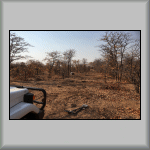 Photo BW-019 |
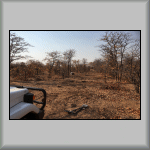 Photo BW-020 |
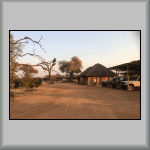 Photo BW-021 |
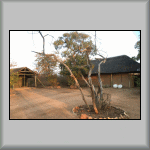 Photo BW-022 |
Today's two projects: Erosion Control and a Bird Census.
The purpose of erosion control is to build wooden barriers to i) prevent soil washing away and ii) trap the grass seeds (that are washed by the rain) to encourage new growth of grass. The volunteers were split into two groups: one group to create, or dig, the pilot holes (for the stakes), while the second group would go off and cut tree branches for both the stakes and the infill.
The process involved:
During the morning, the temperature continued to gradually rise; passing 35°C by lunchtime.
After lunch, at 14:30, we departed to do a bird census, spotting seventeen species. By the way, the route that we took (with times) can be viewed via Google Earth. Click this link to show/hide the list (in chronological order). It is worth spending a few minutes looking at the links, as these birds look amazing; especially in the wild!
On our way out, we (again) passed "Big Mama" - an African Baobab Tree (Photo BW-007). We asked Jo if we could stop and have a closer look on our way back; which we did. And yes, it IS a very large tree; Photo BW-023. These trees can hold a lot of water in their bark, so in the dry season, they are frequently visited by elephants. The damage that they do to the trees' trunks can be clearly seen.
This particular tree is so large, six to eight people can comfortably stand inside it; Photo BW-024. Plus, it can be seen via Google Earth! As mentioned on Tuesday, there is another Baobab tree nearby, nicknamed "Frankenstein".
After leaving "Big Mama", we came across a lonely elephant, drinking at one of the old man-made waterholes (Photo BW-025), and a Rock Fig Tree (Photo BW-026). It is amazing how the roots of these trees find their way through the rock crevasses.
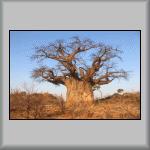 Photo BW-023 |
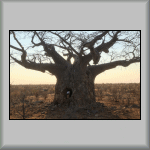 Photo BW-024 |
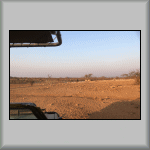 Photo BW-025 |
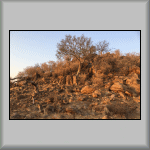 Photo BW-026 |
I didn't sleep very well. The wind increased in strength during the night and the sound of it flapping the tent woke me up several times. However, the temperature wasn't as hot as it had been; it was a lot fresher, thankfully.
Saturdays are usually Picnic Days, departing at about 10:30, so we all took advangtage of staying in bed (well, for me, it was a sleeping bag!) for an extra few hours!
Today's picnic took place at Solomons Wall (GPS: S22 13' 35.0" E28 59' 07.0"). On our way, we came across a small herd of elephants close to the track (Photo BW-027), and at Lekkerpoet Junction, a road sign implying I might have been here before (Photo BW-028)!
Further on, Dicks stopped to talk to a guy guarding the entrance to an ostrich farm; there were many "Keep Out" signs along the fence. It was thought that the farming of ostriches at this place was probably for (American) game and trophy hunters! [See the WARNING paragraph and video at the bottom of this page, as it is about animal hunting! Draw your own conclusions!]
Solomons Wall is an ancient dyke that has been eroded over time, divided (at the time of writing) by a dried-up Motloutse River. After setting up our picnic area in the shade (Photo BW-029), we had lunch.
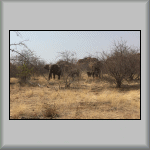 Photo BW-027 |
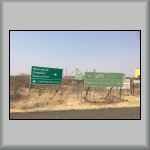 Photo BW-028 |
 Photo BW-029 |
Once we had finished eating and tidied and cleared everything up (or so we thought!), we set off for a walk along the sandy river bed (Photos BW-030 to BW-033 inclusive). In one of the pools (Photo BW-031), three young crocodiles were seen, each approximately 1 metre in length. It was hot! Even though the main river had dried up, I was surprised by the number of pools that remained.
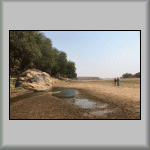 Photo BW-030 |
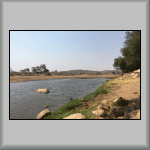 Photo BW-031 |
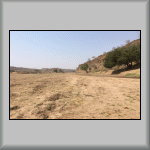 Photo BW-032 |
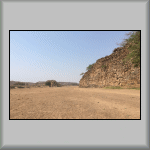 Photo BW-033 |
Upon our return to our picnic area (Photo BW-029), someone suggested we have some refreshing apples from the coolbox. Great idea! However, the coolbox was empty! Unbeknown to us, Dicks thought that an unknown number of baboons must have been nearby, watching us eat our lunch. Once we had left the area for our walk, they made their move and descended from the rocks and/or trees above, and raided the coolbox!
There was one thing that amazed me while we were there: the strength of the mobile phone signal on my phone. It was showing maximum strength, even though the mast, which could barely be seen in the hazy distance, was in South Africa!. At my home in the U.K., the signal strength shows only 4 (out of 5) bars, even though there is a mast a few hundred metres away!
Evening dinner (back at Motswiri camp) was a complete filet of beef that Jane had left in a marinade overnight. This filet would cost a lot in Europe (especially in Rip-off Britain!), but in Botswana, beef is not expensive, due to the large number of cattle in the country. The beef was cooked to perfection over the camp fire!
After dinner, we sat around a computer and watched the Blood Lions documentary; a YouTube trailer is available.
WARNING: Some viewers might find scenes quite disturbing - and that is only the trailer!

YouTube
Trailer
[2 minutes, 05 seconds]
| Back to Start |
 |
Next (Second Week) |
Click to reveal a Home Page QR Symbol
![]()